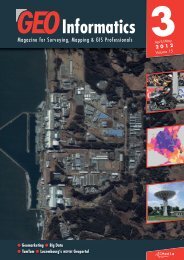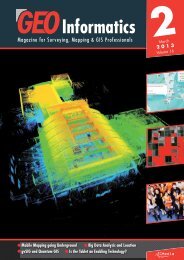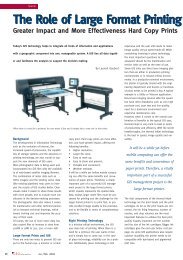2013 - Geoinformatics
2013 - Geoinformatics
2013 - Geoinformatics
You also want an ePaper? Increase the reach of your titles
YUMPU automatically turns print PDFs into web optimized ePapers that Google loves.
49<br />
Mobile, Web and Desktop Apps -<br />
Collaborative & Complimentary<br />
C o l u m n<br />
Columnist Matt Sheehan discusses a collaborative, complimentary system<br />
for web, mobile, desktop and complimentary apps.<br />
Remember the dot com boom in the 90’s,<br />
when the Internet went from being a tool<br />
only known to academics to ubiquity. We<br />
all began feverishly buying computers,<br />
and installing Web browsers to access<br />
network based applications. The world of GIS was<br />
then a world filled with desktop nerds working with<br />
ArcInfo, ArcMap and the like. With Esri getting wind<br />
of this new shift to networked computing the IMS<br />
products were released; we remember fondly<br />
MapObjects IMS and ArcIMS. Using the Internet<br />
we began to be able to build networked GIS apps<br />
which allowed developers to share with everybody<br />
interactive maps.<br />
Exciting times indeed. But for those developing<br />
Internet GIS apps there were two major frustrations:<br />
1) Geo-data was hard to find; in particular base<br />
maps.<br />
2) There were no good API’s or tools for developers<br />
to use. Many older developers remember well building<br />
Internet GIS applications from scratch in Flash;<br />
cool output which took an age to build. For those<br />
unfamiliar with API’s, these are the building blocks<br />
for developing applications, they make the process<br />
easier. In the same way as constructing a car is the<br />
process of combining pre-built components; wheels,<br />
engine etc., this is the same process developers walk<br />
through to build an application. Imagine how long<br />
and painful car making would be if you had to build<br />
every component - wheel, engine - from scratch!<br />
Then along came Google. Gobs of data and API’s<br />
galore. Suddenly the world changed; slippy maps,<br />
easy to find data and no more reinventing the wheel<br />
when it came to coding. It was a joyous time. But<br />
for those of us in the GIS world, we were between<br />
a rock and a hard place; Google Maps was not<br />
GIS. Esri were shocked into action. The mid 2000’s<br />
was Google catch up time. Then came the cloud<br />
and mobile.<br />
The cloud provided server based services hosted by<br />
third party organizations. What does that mean in<br />
English? That organisations no longer need to host,<br />
maintain and configure services and servers in house.<br />
No set up, no load balancing and 24x7 access to<br />
data and apps. And mobile; access to this data and<br />
these apps from anywhere at any time. No longer<br />
were we limited to office or home based computing.<br />
Together mobile and the cloud have set the stage for<br />
a new paradigm, as impactful as the Internet.<br />
The Cloud and ArcGIS Online<br />
So now we can interact with data in 3 ways; via<br />
home and office PC’s using the Web and desktop<br />
applications respectively, and from mobile devices.<br />
For GIS this means different tools for different uses.<br />
Before we delve deeper here, let’s step back and<br />
discuss again the cloud. For those using Esri software,<br />
it is now possible to have ArcGIS Server hosted<br />
and maintained by the third part organisations<br />
in the cloud; all that is required is a license and<br />
monthly hosting fee. But, an organisation still needs<br />
experts familiar with ArcGIS Server to publish data.<br />
Now suppose this process was made simpler.<br />
Suppose publishing geo-data needed no special<br />
skills; imagine data being published in ArcGIS<br />
Server without the need to directly interact with<br />
Server. Welcome ArcGIS Online.<br />
Web, Mobile and Desktop and<br />
Complimentary Apps<br />
Using ArcGIS Online as the central platform, for<br />
storage and access to data, let’s look at collaboration<br />
using mobile, Web and desktop applications.<br />
Imagine a team of field workers. They each have<br />
iPads with an installed mobile ArcGIS Online editing<br />
app. Their task is to collect point data based on<br />
current location, to edit the attributes of each point<br />
and add an image attachment to the new point feature.<br />
When done, each new point feature is uploaded<br />
and stored in a (hosted feature) service in ArcGIS<br />
Online. Next an office based GIS analyst, through<br />
ArcMap 10.1, now has access directly to this new<br />
data. She can perform analysis on this and other<br />
organisational data. Finally, an executive loads a<br />
Web application in his browser. He is presented<br />
with a dashboard, which allows him to view this<br />
data, search and query based on specific criteria,<br />
and visualize the data in map, or chart form to better<br />
see patterns and help with decision making. This<br />
is truly a collaborative, complimentary system. One<br />
day in the not too distant future we will wonder how<br />
we ever used GIS in the isolated vertical way we<br />
use it today.<br />
Matt Sheehan is Principal and Senior<br />
Developer at WebmapSolutions.<br />
The company build location focused<br />
mobile applications for GIS, mapping<br />
and location based services (LBS).<br />
Matt can be reached at<br />
matt@webmapsolutions.com.<br />
Latest News? Visit www.geoinformatics.com










